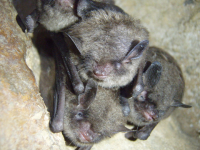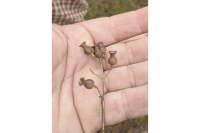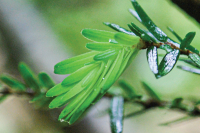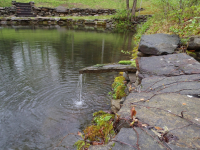Bear encounters: Bears on the prowl for food lead to increased sightings
A bad year for acorns in the higher elevations, coupled with a poor berry crop region wide, has resulted in an influx of black bears into areas where the majority of mountain residents live: the cities, towns and mountainside developments of Western North Carolina.
Hungry bears are looking for acorns, moving into lower elevations in their hunt for food before hibernating for the winter. This has bear and human encounters in WNC tracking on a record pace this year.
“This year is an anomaly because of the acorn crop. There almost none (high) in the mountains,” said biologist Mike Carraway of the N.C. Wildlife Resources Commission. “The bears are looking for food.”
SEE ALSO: Forget the birdfeeders and dog bowls, this bear went straight for the kitchen cupboard
As hungry bears descend from the highlands, motorists are hitting and killing bears on the highway more than ever, particularly in such traditional bear habitat as the Pigeon River Gorge where Interstate 40 cuts through national forest lands.
The Wildlife Resources Commission reports cars have hit and killed more than a dozen black bears in WNC in the last couple of weeks alone. In all 12 months of last year, 10 bears were killed after being struck by motorists.
Additionally, phone calls about “nuisance” bears to North Carolina’s wildlife offices are numbering in the hundreds, well above what’s usually received, Carraway said. The state has received 300 calls so far this year, with the previous high for an entire year standing at about 400, he said.
SEE ALSO: Close encounters of the bear kind
The state does not capture and remove bears anymore: there’s simply nowhere to put them. Additionally, “we can’t catch hundreds of bears,” Carraway said.
The bottom-line on the issue, at least according to the state biologist and the region’s other bear experts? We’ve got to learn how to live with black bears. And to not feed them, to put up bird food and dog food as needed, to slow down and watch out for bears on the highway, and do those other easy, sensible things that will allow bears and humans to peacefully coexist.
Why so many?
The sheer numbers of bears now in the mountains are compounding the problem. Conservation efforts to help black bears in WNC thrive have proven successful, which is terrific, except that right now all of them are converging into the lower elevations in a desperate hunt for food.
“There’s a lot of mobility in and out of the park,” said Bob Miller of the Great Smoky Mountains National Park. “It’s the fall shuffle. But, normally this time of year, there would have been a good acorn crop (in the Smokies) they could have camped out on. They are headed to apple orchards, and so on.”
There have been the same issues, an increase in human and bear encounters, in east Tennessee, Miller said. Camper and bear encounters are down in the Smokies, because the bears have moved on — two backcountry campsites were closed because of bear activity, but park officials probably will reopen those soon, Miller said.
Plus, mother bears responded to a great acorn crop last year by having more cubs than normal this spring. Which is likely why so many local newspapers in recent days are running reader-donated photographs of a mother bears and their young — the mothers are trying to find food to save the cubs from starvation.
Wildland etiquette: The right and wrong way to view wildlife
By Kathryn Sherrard • Contributing Writer
Do you like to visit a state or national park? Why? For thousands of us, it is the chance to see wildlife. People flock to see bears, elk, moose, deer, wild turkeys, foxes, coyotes, bison and alligators. Other animals that are often spotted include raccoons, reptiles and amphibians.
A Walk In The Wild: Encounters of the wildlife kind
By Ed Kelley
If you spend much time in the outdoors, you will eventually have an encounter with wildlife. I am always on the lookout for signs of animal activity. Tracks, scat, scrapings, digging, paths through the leaves or grass, clipped-off leaves or twigs are indicators that some animal has been through the area. Some folks are afraid of going into the woods because of the possibility of meeting a wild animal. These fears are usually unfounded, as most denizens of the forest are fearful of humans.









